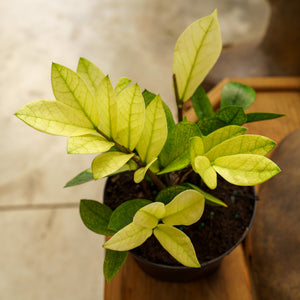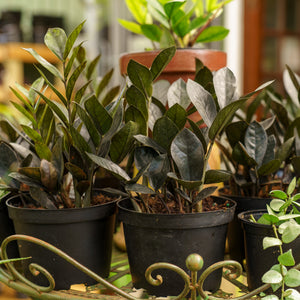The ZZ Plant Guide
The ZZ plant, known for its glossy, dark green leaves and resilience, brings a touch of modern elegance to any indoor space. With its striking foliage and low-maintenance nature, the ZZ plant is perfect for adding a contemporary focal point to homes, offices, and decor settings. Admired for its ability to thrive in a variety of conditions, the ZZ plant is an ideal choice for both novice and experienced plant enthusiasts. Explore our ZZ Plant Guide to learn about cultivating and caring for this fascinating plant and discover how to incorporate it into your indoor spaces for lasting beauty and enjoyment.
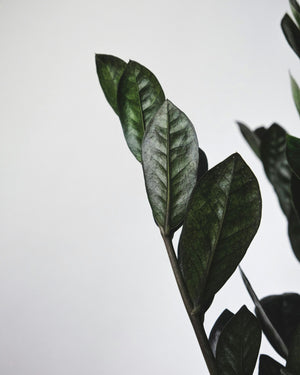
About
The ZZ plant (Zamioculcas zamiifolia) is a tropical perennial native to the grasslands and forests of East Africa. Its name is derived from its botanical classification, and it is commonly referred to as the "Zanzibar Gem." The plant is well-loved for its thick, waxy leaves that grow in a symmetrical pattern along upright, arching stems. Its lush, sculptural appearance complements modern and minimalist design aesthetics.
The ZZ plant is a member of the Araceae family, which includes other popular houseplants such as Philodendrons and Peace Lilies. Its underground rhizomes store water, enabling the plant to survive prolonged periods of drought. This feature, coupled with its tolerance for low light, makes the ZZ plant one of the hardiest indoor plants available.
One of the ZZ plant’s most notable qualities is its air-purifying ability. It helps remove toxins such as benzene, toluene, and xylene from indoor environments, making it not only a decorative piece but also a contributor to healthier living spaces.
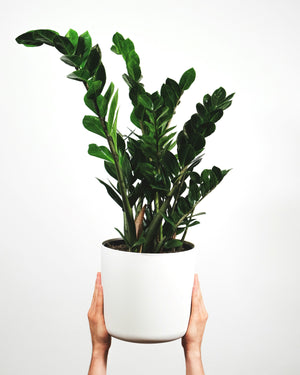
Planting
The ZZ plant requires specific conditions to ensure healthy growth. Follow these guidelines for planting and establishing your ZZ plant:
- Soil: Use a well-draining potting mix, such as a cactus or succulent blend. You can enhance drainage by mixing potting soil with sand, perlite, or pumice.
- Light: ZZ plants thrive in low to medium indirect light but can tolerate low-light conditions, making them suitable for dim corners or offices with minimal natural light. They can also survive under fluorescent lighting, making them ideal for commercial spaces. Avoid direct sunlight, which can scorch their leaves.
- Watering: Allow the soil to dry out completely between waterings. The ZZ plant is drought-tolerant and highly susceptible to overwatering, which can cause root rot. Water thoroughly but infrequently.
- Temperature: The ZZ plant thrives in temperatures between 65-75°F (18-24°C). Protect it from extreme cold and sudden temperature changes.
- Humidity: ZZ plants are well-suited to average indoor humidity levels and do not require additional humidity to thrive.
- Container: Choose a pot with drainage holes to prevent waterlogging. A terracotta pot is ideal for its porous nature, allowing excess moisture to evaporate.
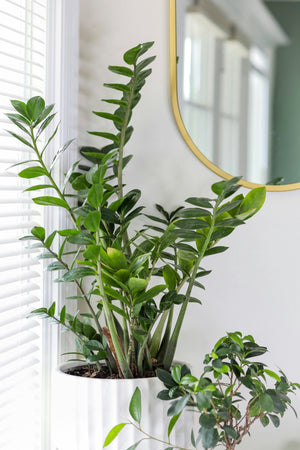
Care
With proper care, the ZZ plant can thrive for years, requiring only minimal attention:
- Watering: Reduce watering in winter when the plant enters dormancy. Overwatering is the most common issue with ZZ plants, so always err on the side of caution.
- Fertilizing: Feed the plant with a balanced, water-soluble fertilizer diluted to half strength once every 2-3 months during the growing season (spring and summer). Avoid over-fertilizing.
- Pruning: Remove yellowing or damaged leaves to maintain the plant’s appearance. Trim back stems if the plant becomes too large or leggy. Use clean, sharp scissors to avoid introducing infections.
- Pests and Diseases: ZZ plants are relatively pest-resistant but can occasionally suffer from spider mites or mealybugs. Treat infestations promptly with insecticidal soap or neem oil.
- Repotting: Repot the ZZ plant every 2-3 years or when it outgrows its current container. Use fresh soil and a slightly larger pot to allow for root growth.
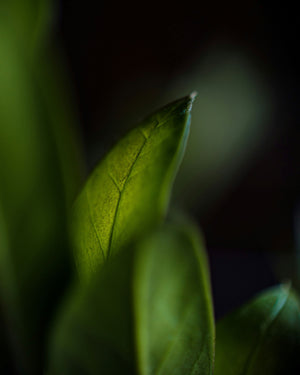
How To Use
The ZZ plant is an incredibly versatile addition to any indoor space, offering both aesthetic appeal and practical benefits. Its adaptability and sleek appearance make it an excellent choice for a wide range of settings, from modern homes to professional offices. Here are some creative ways to incorporate the ZZ plant into your decor:
- Indoor Decor: The ZZ plant’s glossy, upright leaves lend a sophisticated touch to modern interiors. Place it on a side table, entryway console, or as a statement piece in minimalist and industrial design settings.
- Office Spaces: Perfect for desks, conference rooms, or reception areas, the ZZ plant thrives in low light and requires minimal care. Its air-purifying qualities also make it a functional addition to work environments.
- Low-Maintenance Corners: Brighten dimly lit spaces like hallways, bathrooms, or bedrooms with the ZZ plant’s lush foliage. Its ability to thrive in indirect or low light ensures it remains vibrant in less-than-ideal conditions.
- Living Walls: Incorporate ZZ plants into living wall designs for a structured, tropical look. Their symmetrical growth habit and durability make them ideal for vertical displays.
- Gifts: The ZZ plant is a thoughtful and stylish gift for plant lovers and beginners alike. Its hardy nature ensures it will thrive in nearly any home or office setting, making it a long-lasting and memorable present.
Conclusion
The ZZ plant is a stunning and resilient addition to any indoor space. With its glossy foliage, low maintenance needs, and ability to thrive in challenging conditions, the ZZ plant offers a perfect balance of beauty and practicality.
Whether you’re looking to create a modern aesthetic, enhance a workspace, or bring greenery to low-light areas, the ZZ plant is a versatile solution that fits effortlessly into your decor. Its enduring charm, adaptability, and air-purifying qualities make it an essential plant for every collection. Explore the world of ZZ plants and discover how this tropical gem can elevate your indoor environment.


